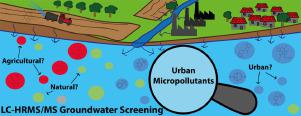Water Research ( IF 11.4 ) Pub Date : 2021-03-02 , DOI: 10.1016/j.watres.2021.116994 Karin Kiefer , Letian Du , Heinz Singer , Juliane Hollender

|
Groundwater is a major drinking water resource but its quality with regard to organic micropollutants (MPs) is insufficiently assessed. Therefore, we aimed to investigate Swiss groundwater more comprehensively using liquid chromatography high-resolution tandem mass spectrometry (LC-HRMS/MS). First, samples from 60 sites were classified as having high or low urban or agricultural influence based on 498 target compounds associated with either urban or agricultural sources. Second, all LC-HRMS signals were related to their potential origin (urban, urban and agricultural, agricultural, or not classifiable) based on their occurrence and intensity in the classified samples. A considerable fraction of estimated concentrations associated with urban and/or agricultural sources could not be explained by the 139 detected targets. The most intense nontarget signals were automatically annotated with structure proposals using MetFrag and SIRIUS4/CSI:FingerID with a list of >988,000 compounds. Additionally, suspect screening was performed for 1162 compounds with predicted high groundwater mobility from primarily urban sources. Finally, 12 nontargets and 11 suspects were identified unequivocally (Level 1), while 17 further compounds were tentatively identified (Level 2a/3). amongst these were 13 pollutants thus far not reported in groundwater, such as: the industrial chemicals 2,5-dichlorobenzenesulfonic acid (19 detections, up to 100 ng L−1), phenylphosponic acid (10 detections, up to 50 ng L−1) triisopropanolamine borate (2 detections, up to 40 ng L−1), O-des[2-aminoethyl]-O-carboxymethyl dehydroamlodipine, a transformation product (TP) of the blood pressure regulator amlodipine (17 detections), and the TP SYN542490 of the herbicide metolachlor (Level 3, 33 detections, estimated concentrations up to 100–500 ng L−1). One monitoring site was far more contaminated than other sites based on estimated total concentrations of potential MPs, which was supported by the elucidation of site-specific nontarget signals such as the carcinogen chlorendic acid, and various naphthalenedisulfonic acids. Many compounds remained unknown, but overall, source related prioritisation proved an effective approach to support identification of compounds in groundwater.
中文翻译:

与源相关的优先级排序后,识别地下水中的LC-HRMS非目标信号
地下水是主要的饮用水资源,但对有机微量污染物(MPs)的质量评估不足。因此,我们旨在使用液相色谱高分辨率串联质谱(LC-HRMS / MS)更全面地研究瑞士地下水。首先,根据与城市或农业来源相关的498种目标化合物,将来自60个地点的样品分类为具有较高或较低的城市或农业影响力。其次,所有LC-HRMS信号均基于其在分类样本中的出现和强度,与其潜在来源(城市,城市和农业,农业或不可分类)相关。139个检测到的目标无法解释与城市和/或农业来源有关的估计浓度的很大一部分。使用MetFrag和SIRIUS4 / CSI:FingerID使用结构建议自动注释最强烈的非目标信号,并列出> 988,000种化合物。此外,对主要来自城市来源的1162种具有预计的高地下水流动性的化合物进行了可疑筛查。最终,明确地确定了12个非目标物和11个可疑物(1级),而初步确定了17个其他化合物(2a / 3级)。其中13种是迄今为止尚未在地下水中报告的污染物,例如:工业化学品2,5-二氯苯磺酸(19种检出物,最高100 ng L 对主要来自城市水源的1162种具有预期高地下水流动性的化合物进行了可疑筛查。最终,明确地确定了12个非目标物和11个可疑物(1级),而初步确定了17个其他化合物(2a / 3级)。其中13种是迄今为止尚未在地下水中报告的污染物,例如:工业化学品2,5-二氯苯磺酸(19种检出物,最高100 ng L 对主要来自城市水源的1162种具有预计的高地下水流动性的化合物进行了可疑筛查。最终,明确地确定了12个非目标物和11个可疑物(1级),而初步确定了17个其他化合物(2a / 3级)。其中13种是迄今为止尚未在地下水中报告的污染物,例如:工业化学品2,5-二氯苯磺酸(19种检出物,最高100 ng L-1),苯膦酸(10次检测,最高50 ng L -1)三异丙醇胺硼酸盐(2次检测,最高40 ng L -1),O-des [2-氨基乙基] -O-羧甲基脱氢氨氯地平(TP)的血压调节剂氨氯地平(17次检测)和TP SYN542490的除草剂甲草胺(3级,33次检测,估计浓度高达100–500 ng L -1)。根据估计的潜在MP的总浓度,一个监测点比其他监测点受污染要严重得多,这得益于阐明了特定于位点的非目标信号,例如致癌物氯丹定酸和各种萘二磺酸。许多化合物仍然是未知的,但是总的来说,与源有关的优先次序证明是一种有效的方法来支持地下水中化合物的鉴定。











































 京公网安备 11010802027423号
京公网安备 11010802027423号